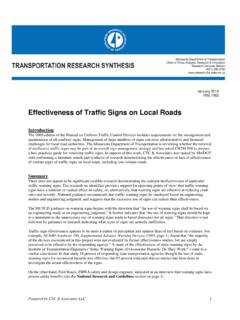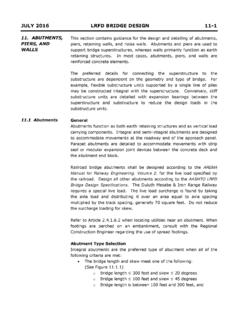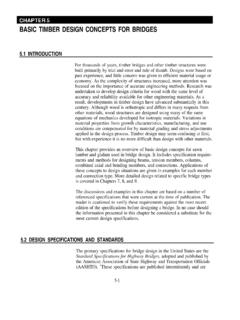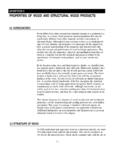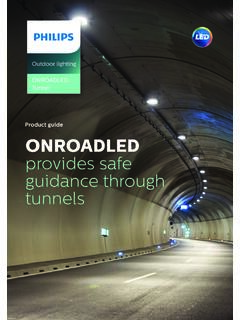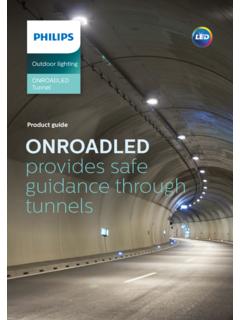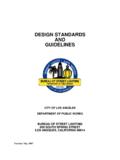Transcription of Chapter 6: Bridges, Over/Underpasses, Rest Areas and ...
1 Chapter 6: Bridges, over / underpasses , rest Chapter 6 Bridges and Grade Separations Areas and Shuttle Sites Introduction This Chapter provides guidelines for planning and designing bikeways on bridges used by vehicular traffic, bicycle and pedestrian overpasses and underpasses , and bicycle accommodations at rest Areas and scenic overlooks. The Chapter concludes with a discussion of bus or van shuttles across barriers to bicycle and pedestrian movement. General Considerations Bridges provide essential links for bicyclists and pedestrians. Understanding the future transportation demand, including bicycle and pedestrian modes, is an important step in life cycle planning of bridges, which are typically reconstructed less frequently than connecting roadways. Bridges and interchanges on major highways are investments of public funds that are often expected to result in new development and significant growth in travel demand. Designed and constructed to last fifty years or more, bridges on or across highways should be planned, designed and constructed with pedestrian and bicycle facilities appropriate for future development patterns.
2 For bridges in urban Areas or other Areas that are likely to see increased development, this may require additional width and accommodations for bicycles and pedestrian modes of travel on or under a bridge . In Areas with low population density, where development is unlikely, bicycles and pedestrians would be reasonably accommodated by current design standards for bridge shoulders. Current bicycle and pedestrian demand may not be a reasonable basis for planning and design of a bridge that will remain in service for 50 years after construction, or up to 70 years after the time the bridge is planned. The determination to provide a grade-separated crossing for bicycles and pedestrians should be analyzed on a case-by-case basis. Analysis is based upon expected bicycle/pedestrian traffic volume, latent demand for bicycle/pedestrian facilities, safety hazards, existing and desired bicycle/pedestrian routing, motor vehicle speeds and volume, and other factors listed in Chapter 4 of this manual.
3 Table 5-12 in Chapter 5 provides guidelines for conditions where a grade-separated bikeway crossing is warranted, but additional factors should be considered based on existing conditions and the community. Determining the appropriate type of grade-separated crossing for bicycles and pedestrians depends on practicality at an individual site. Topography, right-of-way limits, and other constraints may dictate whether an underpass or overpass is more appropriate. Mn/DOT Bikeway Facility Design Manual 169. 170 Chapter 6: Bridges, over / underpasses , rest Areas and Shuttle Sites Highway Bridges with Bikeways bridge structures should be coordinated with approaching bikeways so that facilities are compatible and continuous, with a smooth transition from the bikeway pavement to bridge abutment. On all bridge decks, bicycle-safe expansion joints should be used (as close to 90 degrees to the direction of travel as possible, with small gaps and non-skid plates). Many expansion joints and plates currently in use are very slippery, especially when wet.
4 As a safety consideration, materials should be evaluated for bicycle traction under wet conditions. Where future demand for a bikeway is anticipated, even if current bicycle use is minimal, new highway bridges and bridge rehabilitation should be planned, designed, and constructed with sufficient width to Figure 6-1: accommodate bicycle and Example of accommodating bicycle and pedestrian pedestrian traffic. Bicyclists on traffic along a bridge adjacent to highway traffic highway bridges can be accommodated with a separated bike path, shoulders, bike lanes, wide curb lanes, or sidewalks. However, sidewalks are not preferred for bicycle use, for reasons discussed in Section 5-1. Sidewalks, bikeways, and paved shoulders all shall have a minimum cross slope of 1 percent for drainage, but as required by the ADA, no more than 2 percent for the safety of those with mobility impairments. On highways with high-speed, high-volume vehicle traffic, an off-road path is typically the best design to accommodate bicycle and pedestrian traffic.
5 Where an off-road bikeway is carried across a highway bridge , the bikeway width on the bridge should be the same as the approaching shared-use path, plus an additional m (2 ft) clear width, up to a maximum width of m (14 ft). However, for certain types of bridge structures m (12 ft) may be a practical maximum width based on cost. Carrying the clear width across the structure provides minimum horizontal shy distance from the railing or barrier and offers maneuvering space to allow bicyclists to avoid conflicts with other users. Interchange bridges require careful planning and design to accommodate bicyclists. Each situation should be evaluated to consider vehicle speed and volume, signals, bicycle approach geometrics, bicyclist and pedestrian needs, maintenance, and type of interchange. The bike lane may be carried all the way across the bridge adjacent to a through lane, or The bicycle lane may be placed to the right of a turn lane to a point where the bicyclist can cross the ramp lane at a right angle and continue across the bridge .
6 Mn/DOT Bikeway Facility Design Manual March 2007. Chapter 6: Bridges, over / underpasses , rest Areas and Shuttle Sites 171. If a wide curb lane on the approach roadway is used to accommodate bicyclists, the extra width should be carried across the bridge in a through lane. Where bicycles are legal on both roads, a bicycle lane, wide curb lane, or paved shoulder should be included on the ramps, as well as across and under the bridge . If there is not a designated bicycle or pedestrian facility on a highway bridge , paved shoulders should be provided to accommodate one-way bicycle travel on each side of the bridge . When shoulders are intended to facilitate bicycle traffic, a minimum of m (5 ft) clear width should be provided. Use Table 4-2 and the other factors listed in Chapter 4 to determine if wider shoulders are warranted based upon vehicle traffic volume and speed. Unless bicycles are prohibited by law from using the shoulder of a roadway, the shoulder surface should be as smooth as the travel lanes on the bridge .
7 Rumble strips are not used on bridge shoulders. Retrofitting Bikeways on Existing Highway Bridges On many existing highway bridges, it is possible to use retrofits to accommodate bicyclists and pedestrians. Certain bridge features, however, restrict bicycle access, create unfavorable conditions for bicyclists, and make retrofitting difficult. These features include bridge width narrower than the approach roadway (especially where combined with relatively steep grades), open grated metal decks, low railings or parapets, and certain types of expansion joints, such as finger-type joints, that can cause steering difficulties. These restrictions may be overcome by adding width during reconstruction, creating a bike lane by filling open grating with lightweight concrete, modifying railings, or adding a steel plate or elastomer filler to part of the joint. If a stairway is the only feasible way to connect a shared-use path to a bikeway on an existing bridge , a bicycle wheel ramp should be included on the stairway to facilitate walking a bicycle up the stairs to the bridge .
8 Where a shared-use path is retrofitted onto a bridge , there are a large number of design variables to consider. The best bikeway design must be determined for each case, using a flexible approach to the design process. Several retrofit alternatives are suggested in this section. Carry the shared-use path across the bridge on one side This retrofit should be done where (1) the bridge facility will connect to a path at both ends, (2). sufficient width exists on that side of the bridge or can be obtained by narrowing or re-striping lanes, and (3) provisions are made to physically separate bicycle traffic from motor vehicle traffic. If approach bikeways are two-way, the bridge 's bikeway facility should also be two-way. An existing highway bridge over a barrier such as a roadway, railway, or waterway can be reconfigured to add bicycle facilities for connecting shared-use paths running parallel to and on opposite sides of the barrier. Where feasible, remove or reconfigure vehicle travel lanes to include a 3 m (10 ft) vehicle shoulder and a m (10-12 ft) shared-use path.
9 The shared- use path should be separated from vehicular traffic by a m high (4 ft) barrier. This configuration is illustrated in Figure 6-2. March 2007 Mn/DOT Bikeway Facility Design Manual 172 Chapter 6: Bridges, over / underpasses , rest Areas and Shuttle Sites Provide wide curb lanes or bicycle lanes over the bridge This retrofit is advisable where (1) the shared-use path transitions into bicycle lanes at one end of the bridge , (2) sufficient width exists or can be obtained by widening or re-striping, and (3). there is a separate sidewalk for pedestrians. This option should only be exercised if the bike lane or wide outside lane can be accessed without increasing the potential for wrong-way riding or inappropriate crossing movements. - m (49 - 51 ft). m m m m - m (3 ft) (12 ft) (12 ft) (12 ft) (10 - 12 ft). inside traffic lane traffic lane traffic lane outside EXISTING. shoulder shoulder m m m m .6 m - m (3 ft) (12 ft) (12 ft) (10 ft) (2 ft) (10 - 12 ft). inside traffic lane traffic lane outside concrete shared-use path PROPOSED.
10 Shoulder shoulder barrier Figure 6-2: Shared-Use Path on bridge with Barrier Separation Consider using the existing bridge sidewalks for bicycle traffic This retrofit may be appropriate when the sidewalk is wide enough to accommodate bicyclists and pedestrians, particularly if the approach paths are one-way facilities. In general, however, the designated use of sidewalks (as a signed, shared facility) for bicycle travel is unsatisfactory, particularly if the sidewalk is raised and no railing exists between the sidewalk and traffic lanes. Remember, too, that employing extremely wide sidewalks does not necessarily increase safety, since wide sidewalks encourage higher bicycle speeds and increase potential conflicts with pedestrians and fixed objects. Mn/DOT Bikeway Facility Design Manual March 2007. Chapter 6: Bridges, over / underpasses , rest Areas and Shuttle Sites 173. Sidewalk bikeways should be considered only under certain limited circumstances where unfriendly bicycle and pedestrian elements exist.
